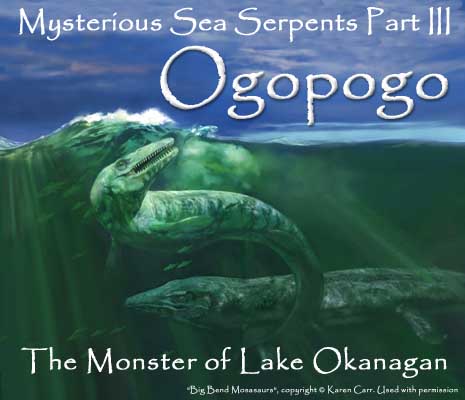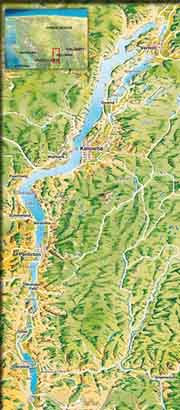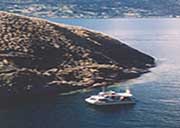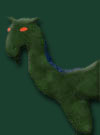
Editorial
|
Fragments
|
Effigy Mounds I
|
Sea Serpents III
|
Atlantis III
Register
for our new Hall of Records Newsletter!
Questions? Comments? Suggestions? Advertising? Press Releases?
Contact us!
Mysterious Sea Serpents Part I: Nessie
|
Part II: Champ
Part IV: The Search Continues
Sea Serpent or Plesiosaur?
|
N'ha-a-itk - The Lake Demon
|
Ogopogo Surfaces
Visiting Lake Okanagan
|
Ogopogo Links
|
Ogopogo Books
|
Sea Serpent Posters

|
|
The Okanagan Valley in southern British Columbia, Canada.
Image from Panorama-Map.com.
|
 ake Okanagan has a secret. Like
Loch Ness of Scotland
and
Lake Champlain
of upstate New York,
Lake Okanagan,
located in
British Columbia,
Canada has its own mysterious resident. Located less than 50 miles north of the
state of Washington,
Lake Okanagan
is actually very similar to Loch Ness and Lake Champlain in several respects:
ake Okanagan has a secret. Like
Loch Ness of Scotland
and
Lake Champlain
of upstate New York,
Lake Okanagan,
located in
British Columbia,
Canada has its own mysterious resident. Located less than 50 miles north of the
state of Washington,
Lake Okanagan
is actually very similar to Loch Ness and Lake Champlain in several respects:
Not only are the lakes very similar in latitude and composition, but the monsters believed to lurk in their depths are also very similar,
both in habits and appearance. Nessie, Champ and Ogopogo are all usually described as huge, serpentine creatures with long necks and
horselike heads, in appearance much like the extinct
plesiosaur.

So what are — or were —
plesiosaurs?
As Richard Forrest explains in
The Plesiosaur Site,
Plesiosaurs were aquatic reptiles, and
were an important part of the marine ecology from the end of the Triassic period 220 million years ago until the end of the Cretaceous
65 million years ago. Their remains have been found on every continent. A typical plesiosaur had a long neck, a broad body, four large
flippers and a relatively short tail. An apt description (of some forms at least) is of "a snake strung through a turtle". Plesiosaurs
were one of the first kinds of extinct animal known to science, and were described as early as 1821. The smallest were about 2m long
as adults, the largest were enormous
pliosaurs
up to 20m long, comparable in size or even bigger than sperm whales.
"1
However, some modern accounts actually describe these creatures as being more like serpents or serpentlike creatures than like
plesiosaurs, due to the undulating motion exhibited in their movements and slender, serpentine construction. Moreover, as Forrest explains,
"Typical descriptions talk of a series of undulating humps. This would imply that the observers are looking at a mammal — reptiles
can only move their bodies from side to side. The bodies of plesiosaurs were rigid, and could certainly not undulate either up and
down or from side to side."2
So, if reptiles (including snakes) can only move from side to side, and cannot replicate the vertical rippling motion typical of
"sea serpent" and lake monster sightings, and the plesiosaur's structure was too rigid to allow for this type of motion, this leaves the most likely
candidates for these mysterious sea serpents to be the Mosasaur (shown at the
top
of this page), the zeugledon or
basilosaurus
(forms of prehistoric whale) or, as Coleman believes, a completely separate,
unknown reptilian species.3

The Shushwap and Okanekane Indians who still inhabit the area around Lake Okanagan still tell tales about Ogopogo's sinister history.
Calling him N'ha-a-itk,
these aboriginal inhabitants of the area tell a less than positive story about Ogopogo's
past. One Native American legend has it that the monster was originally a demon-possessed man who had murdered a well-known local man
who was named "Old Kan-He-Kan", after whom the lake was later named "Okanagan". As punishment for his crime, "the Indian gods changed
the murderer into a lake serpent so he would forever be at the scene of his crime and suffer eternal remorse. The creature's name
became "N'ha-A-Itk" which roughly translates into sacred creature of the water, water god or lake
demon."4
This sacred creature of the water was more truly a lake demon, carrying on the same murderous exploits that it had carried on in life.
In order to avoid the wrath of the creature, Native Americans devised methods of placating the creature, including making animal
sacrifices.
According to both the Shushwap and Okanekane Indians, Ogopogo was originally a violent and unpredictable creature. The monster was known
to these peoples as N'ha-a-itk, or "the lake demon," because they believed that it was an evil supernatural entity with great power and
ill intent. To appease this horrible monster, they would carry sacrifices with them whenever they crossed the lake. Such gifts to
N'ha-a-itk included lumps of deer meat or live puppies, chickens, and ducks. The sacrifices could be thrown to the monster when it neared
or placed in a separate canoe to be floated several feet ahead of the humans.5

|
|
Rattlesnake Island, also called "Monster Island" by the locals. Ogopogo's lair is believed to be in the many unexplored caves
located between the island and the mainland. Copyright � 2002
Can Pro Productions. All Rights Reserved.
|
Thus, for many centuries, Ogopogo was known as a vicious killer, indiscriminately feeding on humans and animals alike. Most Shushwap and
Okanekane rarely ventured out onto the lake without at least a token sacrifice, and only the bravest (or most foolhardy) dared pass near
Squally Point. There, it was believed, the monster (or monsters) lay hidden in caves deep beneath the waters between Squally Point and a
small, barren island called
Rattlesnake Island
some distance from the shore. This island, now popularly known as "Monster Island," was a veritable charnel house of
horror. As Blackman explains, "Braves foolish enough to land on Monster Island often found it littered with bones, skins, bloodstains,
and other signs of the monster's gruesome dining habits."6
Several Native American legends exist regarding attacks by the monster on humans. One of the most prominent involves one local chief who
scoffed at his Medicine Man's superstitious fear of the semi-legendary creature, and proceeded to canoe past Squally Point without making
the appropriate sacrifices:
Chief Timbasket and family who, many years ago were visiting the Tisn-stip-ep-tinsub tribe of south Kelowna, were very sceptical of
N'ha-a-itk as they watched a village shaman (medicine man) prepare for the trip down the lake. The canoes that were to accompany the
honoured guest were marked with a special symbol and a live dog was to be sacrificed at Squally Point. The canoes also had to travel
at a certain distance from the shore and every precaution was to be taken to avoid rousing the fearsome beast. But the chief was not
to be frightened by myth nor would he steer a round-about course simply to keep away from the rocky point. As he paddled along close
to shore, waves suddenly arose and in a flurry of lashing water, the chief and family disappeared. The Indians knew well it was the
action of the lake monster which had whipped up the engulfing waves by lashing his tail.7


As settlers moved into the area in the 1860s, reports of Naitaka predictably increased, as more sets of eyes came to bear on the
lake and its environs. Early on, settlers had kept a sharp eye on the lake, keeping armed patrols on the shore, and even occasionally making
sacrifices as had been prescribed by the Okanekane Indians. However, attacks on humans decreased over time, to the point where, by 1924,
attacks on humans had ceased altogether.
The very first sighting of Naitaka by a settler was in 1852 by a woman by the name of Mrs. John Allison. Mrs. Allison, who had seen
the creature basking on the surface of the lake, had taken upon herself the task of systematically collecting all
of the available sightings of the creature, both from the Native Americans and from other settlers. Over time, the increasing quantity
and quality of sightings has created a picture of Naitaka that has some fairly specific characteristics:
In virtually every account, Ogopogo is described as a long, sinuous creature almost seventy feet long. Its head is usually described as
being "sheeplike" or "horselike", due to the general shape of its skull, its large eyes, and its blunt nose. Two large horns erupt from
this odd head, and a jagged fin begins at the creature's skull and continues down the length of its body. Adorning the monster's chin
are thick whiskers resembling a beard. The rest of Ogopogo's skin is composed of sizable scales, ranging from dark green to pitch-black
in color. Four flippers sprout from the monster's slender body, which is roughly two feet thick. The serpent ends in a long, forked tail
capable of propelling the beast at speeds surpassing forty miles per hour. While Ogopogo is largely aquatic, it can also venture onto
land. Six-inch "flipper-prints" have been discovered near the lake, and at least one witness spotted the monster lying on a
beach.8
Naitaka picked up the name "Ogopogo" under some fairly curious circumstances. A popular English tune from a play written during the 1920s
by David Burnaby spoke of a mysterious creature called "the Ogopogo", whose "mother was an earwig, his father was a snail". This nonsensical
song and the play it came from was a big hit during its time, and it found its way all the way to British Columbia, where it was put on by
a group of local amateur players called "The Kalamalka Players". One day at a Vancouver Board of Trade meeting luncheon the Ogopogo song
from the local play was sung again as entertainment, and was so well received, that it was decided that day that the creature formerly
known as Naitaka would be renamed "Ogopogo". Shortly thereafter, a parody of the original Ogopogo song was written by H.F. Beattie,
ex-Secretary of the Vernon Board of Trade. (Click
here
to download the PDF file of the original song, provided by
Welcome to Ogopogo Country.)
The song as written by Davy Burnaby ran thus:
One fine day in Hindustan, I met a funny little man
With googly eyes and lantern jaws; with a new silk hat and some old plus-fours
When I said to that quaint old chap; Whey do you carry that big steel trap
That butterfly net and that old gun? He replied, Listen here my son.
"I'm looking for the Ogopogo. The funny little Ogopogo.
His mother was an earwig, his father was a snail
I'm going to put a little bit of salt on his tail
I want to find the Ogopogo, while he's playing on his old banjo
The Lord Mayor of London, the Lord Mayor of London
The Lord Mayor of London wants
To put him in the Lord Mayor's show."
And the parody by H.F.Beattie:
"Oh! Vancouver Board of Trade
Gird up your loins; be not dismayed
Crusaders stalwart from the coast
Fill each his glass, and hear Vernon's toast
Ante-deluvian or B.C.
A monster you may chance to see
a D--- sight more up-to-date you will say
Join the chorus with a Hip-Hooray
I'm looking for the Ogopogo
The bunny-hugging Ogopogo
His mother was a mutton* and his father was a whale
I'm going to put a little bit of salt on his tail
I'm looking for the Ogopogo
As told me by Harwood (Joe)
The Lieutenant-Governor The Lieutenant-Governor
The Lieutenant-Governor wants
To put him in the B.C. show."9
Since 1924, when the name
Ogopogo
was applied to the creature, it has obliged by appearing more and more often, and no one to date has
been injured or killed by the creature. Whether breaching the surface or just sunning itself on the beach, Ogopogo makes himself known,
giving us just enough information about him (or her) to keep up our interest in the pursuit. One of the leading research groups in the
field is the
British Columbia Scientific Cryptozoology Club
(BCSCC), which has carried out five expeditions to search for the monster since 1989. Several pictures and some videotape have been
captured of the creature, some of which is actually quite compelling. Another site,
Ogoposearch.com,
offers a $2,000,000 reward "to any person finding alive and definitively verifying Ogopogo's existence". Though the offer for
$2,000,000 expired on September 3, 2001, the search continues.

The Okanagan Valley is a rich, beautiful corner of the Pacific Northwest, offering scenic beauty regardless of your luck in spotting the
beast. The Okanagan area is renowned for its
golfing,
and
hiking,
camping,
boating,
fishing and various water sports are also very popular during the summer.
Ogopogo has become a beloved feature of the Lake Okanagan area, and has even been made an honorary citizen of the city of
Kelowna.
The lake is also surrounded by several other cities besides
Kelowna
that also offer affordable
restaurants,
attractions,
shopping
and
lodging,
including
Vernon,
Peachland,
Westbank,
Penticton,
Summerland
and
Osoyoos.
The Okanagan Valley is a favorite vacation destination for Canadians, as it is nearby, has beautiful scenery, is warmer year-round, and of
course, it has a certain mystique brought about by the creature. Ogopogo's favorite place to make appearances is apparently just south of
Kelowna in waters near
Peachland,
so
make your plans
accordingly.

Mysterious Sea Serpents Part I: Nessie
|
Part II: Champ
Part IV: The Search Continues
Editorial
|
Fragments
|
Effigy Mounds I
|
Sea Serpents III
|
Atlantis III
Register
for our new Hall of Records Newsletter!
Questions? Comments? Suggestions? Advertising? Press Releases?
Contact us!




 Welcome to Ogopogo Country: The Legend
Welcome to Ogopogo Country: The Legend
 Welcome to Ogopogo Country: Native's History
Welcome to Ogopogo Country: Native's History
 Welcome to Ogopogo Country: Ogopogo Press Review
Welcome to Ogopogo Country: Ogopogo Press Review
 Welcome to Ogopogo Country: Interview w/Arlene Gaal
Welcome to Ogopogo Country: Interview w/Arlene Gaal
 British Columbia Scientific Cryptozoology Club: Ogopogo
British Columbia Scientific Cryptozoology Club: Ogopogo
 OgopogoSearch.com
OgopogoSearch.com
 ParaScope.com: Ogopogo
ParaScope.com: Ogopogo
 Dans World: Ogopogo Video as Seen on TV
Dans World: Ogopogo Video as Seen on TV
 StrangeMag.com: Ogopogo, Canadian Lake Monster
StrangeMag.com: Ogopogo, Canadian Lake Monster
 TrueAuthority.com: Ogopogo, of Lake Okanagan
TrueAuthority.com: Ogopogo, of Lake Okanagan
 Seesya.com: The Legend Hunters - The Search for Ogopogo
Seesya.com: The Legend Hunters - The Search for Ogopogo
 Fox's Million Dollar Mysteries: Ogopogo
Fox's Million Dollar Mysteries: Ogopogo
 Tour Canada: Ogopogo, Real or Myth?
Tour Canada: Ogopogo, Real or Myth?
 Okanagan.com: Ogopogo
Okanagan.com: Ogopogo
 AboutKelowna.com: Ogopogo
AboutKelowna.com: Ogopogo
 VTours: Ogopogo
VTours: Ogopogo
 SunnyOkanagan.com: Unpublished Stories of Ogopogo
SunnyOkanagan.com: Unpublished Stories of Ogopogo
 Science Frontiers Online: 1989 Sightings of Ogopogo
Science Frontiers Online: 1989 Sightings of Ogopogo
 Community Internet Service: Ogopogo
Community Internet Service: Ogopogo
 Linden Lanes School Heritage Fair: Ogopogo
Linden Lanes School Heritage Fair: Ogopogo
 50 Ogopogo Links
50 Ogopogo Links
 Canada.com
Canada.com
 World Sites Atlas: British Columbia, Canada
World Sites Atlas: British Columbia, Canada
 Okanagan.com: Map of the Okanagan Valley
Okanagan.com: Map of the Okanagan Valley
 Panorama-Map.com: Map of the Okanagan Valley
Panorama-Map.com: Map of the Okanagan Valley
 Thompson Okanagan Region Tourism
Thompson Okanagan Region Tourism
 Thompson Okanagan Region Fast Facts
Thompson Okanagan Region Fast Facts
 Thompson Okanagan Region Vacation Planning
Thompson Okanagan Region Vacation Planning
 Thompson Okanagan Region Calendar of Events
Thompson Okanagan Region Calendar of Events
 TourCanada.com
TourCanada.com
 eTourist.ca: Tourist Network of Canada
eTourist.ca: Tourist Network of Canada
 eTourist.ca: Tourist Network of Canada: Canada Facts & Figures
eTourist.ca: Tourist Network of Canada: Canada Facts & Figures
 Okanagan.com
Okanagan.com
 British Columbia Vacation and Business Travel Guide: Okanagan Valley
British Columbia Vacation and Business Travel Guide: Okanagan Valley
 SunnyOkanagan.com
SunnyOkanagan.com
 Kelowna Chamber of Commerce
Kelowna Chamber of Commerce
 Kelowna, British Columbia, Canada Welcomes You
Kelowna, British Columbia, Canada Welcomes You
 VernonTourism.com
VernonTourism.com
 Peachland
Peachland
 Westbank
Westbank
 Penticton & Wine Country Chamber of Commerce
Penticton & Wine Country Chamber of Commerce
 Summerland Chamber of Commerce
Summerland Chamber of Commerce
 FoundLocally.com: Summerland
FoundLocally.com: Summerland
 Osoyoos Chamber of Commerce
Osoyoos Chamber of Commerce
 TalkingGuides.com: Kelowna Area and Attractions Guide for the Okanagan
TalkingGuides.com: Kelowna Area and Attractions Guide for the Okanagan
 TalkingGuides.com: Kelowna Area Restaurants
TalkingGuides.com: Kelowna Area Restaurants
 TalkingGuides.com: Kelowna Area Attractions
TalkingGuides.com: Kelowna Area Attractions
 TalkingGuides.com: Kelowna Area Shopping
TalkingGuides.com: Kelowna Area Shopping
 TalkingGuides.com: Kelowna Area Lodging
TalkingGuides.com: Kelowna Area Lodging
 TalkingGuides.com: Kelowna Area Highway Map
TalkingGuides.com: Kelowna Area Highway Map
 TalkingGuides.com: Kelowna City Parking Map
TalkingGuides.com: Kelowna City Parking Map
 Ohh Canada: Okanagan Homestay with Heart
Ohh Canada: Okanagan Homestay with Heart
 Okanagan Reservations
Okanagan Reservations
 Okanagan Limousine
Okanagan Limousine
 BoatsAndPlaces.com: Lake Okanagan
BoatsAndPlaces.com: Lake Okanagan
 Lake Okanagan Resort
Lake Okanagan Resort
 Lake Okanagan Resort: Map
Lake Okanagan Resort: Map
 Okanagan Bed and Breakfast Accomodations: Lake Country Inn
Okanagan Bed and Breakfast Accomodations: Lake Country Inn
 VTours: The Floating Bridge
VTours: The Floating Bridge
 Kootenay Backroads Heritage Tour
Kootenay Backroads Heritage Tour
 Golf Okanagan
Golf Okanagan
 Dusty Carver Designs: Ogopogo
Dusty Carver Designs: Ogopogo
 CurrencyGuide.com
CurrencyGuide.com

 The Book of Sea Monsters
The Book of Sea Monsters
Bob Eggleston and Nigel Suckling
Rating:
   
For millennia, humankind has been fascinated by the awesome power of the sea and the creatures sheltered by its depths.
In the past, ocean crossings toward new horizons were not just challenges of the physical elements, but defiances of the perils
which the human imagination projects onto the unknown. Now, in The Book of Sea Monsters, these mythical creatures of the
deep are vividly brought to life by award-winning artist Bob Eggleton. Exploring the myth, legend, scientific documentation and
fiction inspired by the creatures like the serpent of Midgard, the biblical Leviathan, the Kraken and the infamous monster of
Loch Ness, The Book of Sea Monsters will thrill and fascinate all lovers of mythology, legend and the many secrets of the sea.
(From the back cover)
Click
here
to buy this book.
Ogopogo: The True Story of the Okanagan Lake Million Dollar Monster
Arlene Gaal
Click
here
to buy this book.
 Naitaka
Naitaka
Lee Murphy
Nearly two years after the horrifying debacle of WHERE LEGENDS ROAM, cryptozoologist George Kodiak has come to British Columbia's Lake Okanagan; reputed to be the home of Naitaka, an ancient monster believed to exist in the lake's icy depths for the past twenty thousand years. Kodiak anticipates this expedition to be a time of discovery and excitement. But over the years he has made enemies. Nasty ones. And they have other ideas for him... (Review by Amazon.com)
Click
here
to buy this book.
 In the Domain of the Lake Monsters
In the Domain of the Lake Monsters
John Kirk III
Rating:
   
A fascinating survey of the "unknown animals of outlandish size" that lurk in lakes and oceans around the world, and one that will appeal to both the converted and the curious. The book includes a complete, comprehensive listing of sightings, organized by geography. (Review by Amazon.com)
Click
here
to buy this book.
 The Field Guide to North American Monsters
The Field Guide to North American Monsters
W. Haden Blackman
Rating:
   
Gleaned from Native American legends, American folklore, and modern sightings, this is the first-ever collection cataloging the vast expanse of bizarre creatures inhabiting North America. Laid out like a field guide to birds or mammals, the book helps the reader become familiar with each monster through photos (when available), drawings, and each creature's vital statistics: distinguishing features, range and habitat, diet, the source reporting the monster, and a rating of the likelihood of spotting each creature in the wild. (Review by Amazon.com)
Click
here
to buy this book.
 Atlas of the Mysterious in North America
Atlas of the Mysterious in North America
Rosemary Ellen Guiley
Rating:
   
This atlas locates and gives brief descriptions of the most intriguing places in the United States and Canada. Burial mounds, sacred places, ghost lights, haunted spots and even the locations of cryptozoological sightings are covered. Find out if your state is home to a mystery, or peruse the atlas to get ideas about where to go for your next vacation.
(Review by Amazon.com)
Click
here
to buy this book.
 Cryptozoology A to Z: The Encyclopedia of Loch Monsters, Sasquatch, Chupacabras, and Other Authentic Mysteries of Nature
Cryptozoology A to Z: The Encyclopedia of Loch Monsters, Sasquatch, Chupacabras, and Other Authentic Mysteries of Nature
Loren Coleman, Jerome Clark
Rating:
   
The Loch Ness Monster, Bigfoot, the Abominable Snowman -- these are the names of the elusive beasts that have caught the eye and captured the imaginations of people around the world for centuries. Recently, tales of these "monsters" have been corroborated by an increase in sightings, and out of these legends a new science has been born: cryptozoology -- the study of hidden animals.
Cryptozoology A to Z, the first encyclopedia of its kind, contains nearly two hundred entries, including cryptids (the name given to these unusual beasts), new animal finds, and the explorers and scientists who search for them. Loren Coleman, one of the world's leading cryptozoologists, teams up with Jerome Clark, editor and author of several encyclopedias, to provide these definitive descriptions and many never-before-published drawings and photographs from eyewitnesses' detailed accounts. Full of insights into the methods of these scientists, exciting tales of discovery, and the history and evolution of this field, Cryptozoology A to Z is the most complete reference ever of the newest zoological science.
(Review by Amazon.com)
Click
here
to buy this book.
More Sea Serpent books...


 Loch Ness Monster
Loch Ness Monster
Size: 34 in x 24 in
Rating:
    
The original and still the best. The classic "Surgeon's Photo" has since been debunked as a clever hoax, but it still remains as a cryptozoological classic. (Review by Mysterious World)
Click
here
to buy this poster.
Editorial
|
Fragments
|
Effigy Mounds I
|
Sea Serpents III
|
Atlantis III
Register
for our new Hall of Records Newsletter!
Questions? Comments? Suggestions? Advertising? Press Releases?
Contact us!
|

